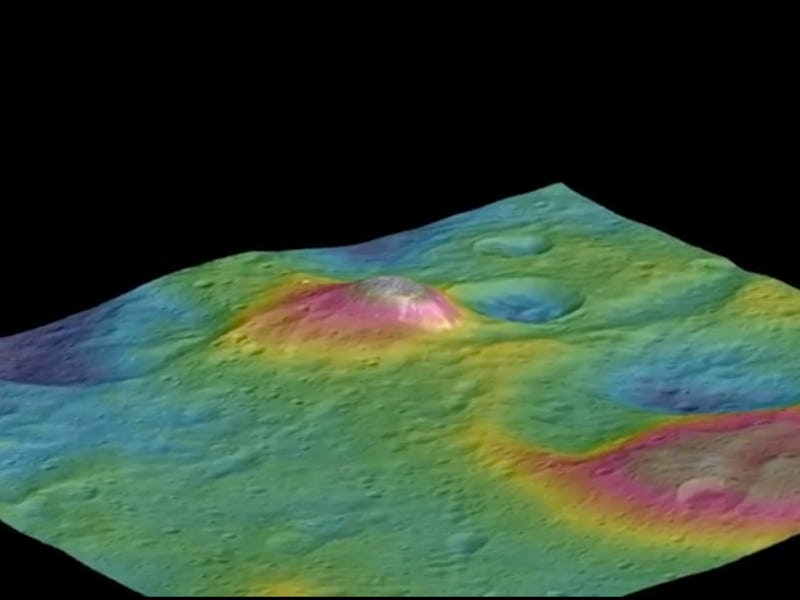Ceres's Cryovolcano Is Way Cooler Than Anyone Imagined

Ceres might not have the same name recognition as the solar system’s eight planets (RIP Pluto), but NASA’s Dawn mission has gone a long way to show that the little dwarf planet is so much more than a cold hunk of rock and ice.
Ceres is the largest object in the asteroid belt between Mars and Jupiter, and the only one big enough to attain a rounded shape by the force of its own gravity — in spite of weighing just one percent of Earth’s moon. A series of research papers published Thursday in Science show that Ceres is a surprisingly dynamic world — affected not only by asteroid impacts but also by internal geological forces. These studies are all based on data and images collected by the Dawn spacecraft, which is currently in orbit around the dwarf planet.
The most exciting discovery? There’s reason to believe that that Ceres hosts a cryovolcano — which is as awesome as it sounds. Cryovolcanoes function physically like a volcano on Earth, except in a much colder system. They are not fed by molten lava, but by a mix of water and volatile compounds trapped underground. This slurry becomes heated and pressurized until it erupts through the crust, flowing like lava until it solidifies as ice on the surface.
Ceres’s cryovolcano, named Ahuna Mons, is described in an article by Ottaviano Ruesch with NASA’s Jet Propulsion Laboratory, and colleagues. It’s among the most compelling direct evidence of cryovolcanism on icy space rocks ever found.
More evidence of Ceres as a constantly evolving world: A separate study found evidence for water frozen as ice on the surface of the dwarf planet. This is surprising, because according to computer models any ice present on the surface of the planet would evaporate away into space within a matter of decades. The authors suspect that a recent event — perhaps an asteroid impact or a landslide from tectonic processes — exposed water ice that had previously been sheltered beneath the rocky surface.
Additional articles found signs of solar wind impacts; a crust made from a mixture of rock and ice; geological features including craters, domes, lobate flows, and other structures; and the widespread distribution of clay-like phyllosilicate minerals, which require water to form and point to the significant role of water in the shaping of the dwarf planet.
As exciting as these findings are, they could be just the tip of the rocky iceberg. After eight months of observing Ceres from an altitude of 240 miles, Dawn will begin to spiral away from the dwarf planet on Friday, stopping 910 miles away. This new vantage point could offer fresh insights into the inner-workings of the space rock. It will also help to limit the spacecraft’s use of hydrazine — the fuel it burns for self-propulsion and communication with Earth — since less energy is required to overcome the dwarf planet’s gravity at higher altitudes.